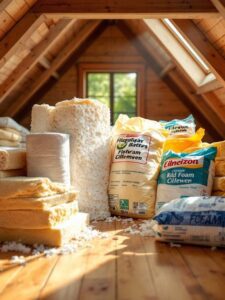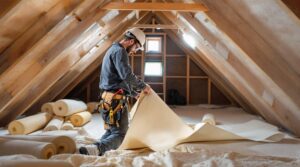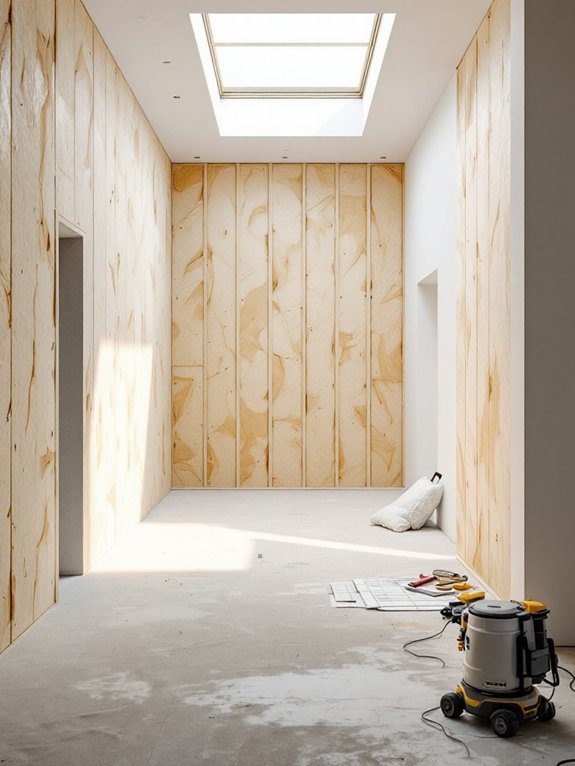External wall insulation offers you a thorough solution to improve your home’s thermal efficiency and reduce energy costs. You’ll benefit from a multi-layered system that prevents heat loss through walls, potentially cutting heating bills by 15-35%. The insulation protects your building’s structure from weather damage while enhancing its exterior appearance. With available government grants and a 25+ year lifespan, this investment delivers long-term value that extends far beyond initial improvements.
Key Takeaways
- External wall insulation reduces annual heating costs by 15-35% through improved thermal performance and prevention of heat loss.
- Professional installation creates a protective thermal barrier that minimizes heat escape through weak points in walls.
- Initial investment typically pays for itself within 5-8 years through sustained energy bill savings.
- Weather-resistant finish protects against dampness, frost damage, and structural deterioration while extending building lifespan.
- Property value increases through improved aesthetics, with various texture and color options available for facade transformation.
Understanding External Wall Insulation: How It Works

External wall insulation functions as a protective thermal barrier that’s installed on a building’s exterior walls to minimize heat transfer between indoor and outdoor environments.
You’ll find this system comprises multiple layers, including insulation materials like mineral wool, expanded polystyrene, or phenolic foam, secured directly to your existing wall structure.
When you invest in external wall insulation, you’re effectively wrapping your home in a continuous protective layer that prevents thermal bridging – the escape of heat through weak points in your wall construction.
The system includes mechanical fixings that anchor the insulation boards, a reinforced base coat, and a weather-resistant finish.
This thorough approach guarantees you’re getting maximum thermal performance while maintaining your building’s structural integrity and aesthetic appeal.
Energy Savings and Cost Benefits
Installing proper wall insulation can reduce your annual heating costs by 15-35%, depending on your climate zone and existing wall construction.
You’ll notice immediate savings on your energy bills as the insulation prevents heat from escaping through your walls during winter and keeps your home cooler in summer.
Professional energy audits can help you determine your potential savings by analyzing your home’s thermal performance.
A detailed cost analysis typically shows that while external wall insulation requires significant upfront investment, you’ll recover these costs through reduced energy bills within 5-8 years.
The savings continue to accumulate throughout the insulation’s 25+ year lifespan.
You’re also protecting yourself against future energy price increases, as your home will require less heating and cooling to maintain comfortable temperatures year-round.
Weather Protection and Building Longevity

When properly installed, external wall insulation creates a robust protective barrier that shields your home’s structural elements from harsh weather conditions.
Your walls gain enhanced moisture resistance, preventing rainwater penetration and reducing the risk of damp-related issues that can compromise your property’s integrity.
The insulation system’s thermal stability helps regulate temperature fluctuations, protecting your walls from expansion and contraction cycles that often lead to cracks and structural deterioration.
You’ll notice fewer maintenance requirements as the insulation minimizes frost damage and prevents the breakdown of mortar joints.
This protection extends your building’s lifespan by reducing the impact of freeze-thaw cycles and protecting against wind-driven rain.
The result is a more durable home that maintains its structural integrity and value while requiring less frequent repairs and maintenance over time.
Aesthetic Improvements and Property Value
Modern wall insulation systems offer you three distinct aesthetic advantages: a refreshed exterior appearance, diverse finish options, and enhanced architectural appeal.
You’ll discover a wide range of textures and colors that can transform your home’s facade, from smooth rendered finishes to textured brick effects.
The improved curb appeal directly impacts your property’s resale value, as potential buyers are increasingly drawn to homes with modern, well-maintained exteriors.
You can choose finishes that complement your neighborhood’s character while standing out for their quality and design.
The system allows you to incorporate architectural details, such as quoins and corbels, that weren’t previously feasible with your original wall construction.
Installation Process and Timeline

Since external wall insulation requires careful planning and coordination, you’ll need to understand the distinct phases of the installation process. The project timeline typically spans 2-4 weeks, depending on your property’s size and complexity. You’ll join thousands of UK homeowners who’ve successfully completed this upgrade through a systematic approach.
| Phase | Installation Steps | Timeline |
|---|---|---|
| 1 | Survey and Planning | 3-5 days |
| 2 | Scaffolding Setup | 1-2 days |
| 3 | Surface Preparation | 2-3 days |
| 4 | Insulation Board Fixing | 5-7 days |
| 5 | Rendering and Finishing | 5-7 days |
Your contractor will guide you through each phase, guaranteeing proper drying times between steps. Weather conditions can affect the installation timeline, particularly during rendering, so scheduling during appropriate seasons maximizes efficiency and guarantees ideal results.
Environmental Impact and Carbon Footprint Reduction
Through proper external wall insulation, you’ll considerably reduce your home’s carbon footprint while contributing to broader environmental conservation efforts.
By minimizing heat loss, your home requires less energy for heating, which directly translates to lower CO2 emissions from your heating system.
Modern external wall insulation systems incorporate sustainable materials that are manufactured using eco-friendly practices.
You’ll join a community of environmentally conscious homeowners who understand that reducing energy consumption is essential for fighting climate change.
The insulation can decrease your property’s carbon emissions by up to 50%, depending on your current wall type and heating system.
Additionally, the extended lifespan of quality insulation materials means fewer replacements over time, further reducing waste and environmental impact in the long term.
Grants and Financial Support Options

Various government initiatives and private sector programs can help offset the substantial initial costs of external wall insulation installation.
You’ll find several funding opportunities through both local and national schemes that make this home improvement more accessible.
Common government incentives available to UK homeowners include:
- The Energy Company Obligation (ECO) scheme – providing support for low-income households
- Green Homes Grant Local Authority Delivery – offering region-specific funding
- Home Energy Scotland Loan – available for Scottish residents with interest-free options
- Local council grants – varying by region with specific eligibility criteria
You’ll need to check your eligibility for these programs through official channels, as criteria and available funding can change periodically.
Many installers can also guide you through the application process and help identify the most suitable financial support options for your situation.
Frequently Asked Questions
Can External Wall Insulation Be Installed if I Have a North-Facing Garden?
Yes, you can install external wall insulation with a north-facing garden, but consider installation considerations like reduced drying times during application and potential garden shading impacts, which your installer will need to assess carefully.
Will External Wall Insulation Affect My Home Insurance Premiums?
While you’ll need to notify your insurer, properly installed external wall insulation often leads to positive premium adjustments. You’ll join many homeowners who’ve seen their insurance coverage improve due to reduced property risks.
How Does External Wall Insulation Impact Mobile Phone Signal Inside the House?
You may notice some signal interference from your mobile phone, as insulation materials can slightly weaken radio waves. However, modern phones are designed to compensate, and most homeowners don’t experience significant reception problems.
Can Security Cameras and Outdoor Lights Be Reinstalled After Installation?
Like a medieval castle’s watchmen, you’ll be glad to know that your security features can be reinstalled. Following proper installation guidelines, you can safely reattach cameras and lights directly onto the new insulated surface.
Does External Wall Insulation Require Regular Maintenance or Cleaning?
You’ll need minimal maintenance for your external wall insulation. Check annually for damage and clean every 2-3 years using gentle pressure washing or soft brushing methods. Regular inspections help maintain its protective qualities.
Conclusion
External wall insulation stands as a robust shield for your home, functioning like a thermal cocoon that wraps your property in protection. You’ll see your energy bills plummet while your home’s value soars. When paired with available government grants, it’s a calculated investment that delivers measurable returns through enhanced thermal performance, structural longevity, and reduced carbon emissions. The data-driven benefits make it a technically sound choice for UK homeowners.









4 Responses
Your point of view caught my eye and was very interesting. Thanks. I have a question for you. https://www.binance.info/bg/register?ref=V2H9AFPY
Thanks for sharing. I read many of your blog posts, cool, your blog is very good. https://accounts.binance.com/es-MX/register-person?ref=GJY4VW8W
Your point of view caught my eye and was very interesting. Thanks. I have a question for you. https://accounts.binance.info/en-ZA/register-person?ref=B4EPR6J0
Your point of view caught my eye and was very interesting. Thanks. I have a question for you. https://accounts.binance.com/es-MX/register-person?ref=GJY4VW8W